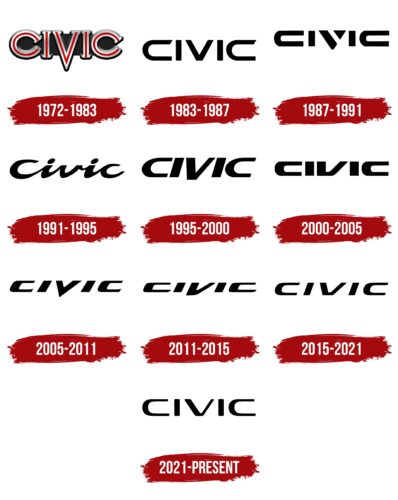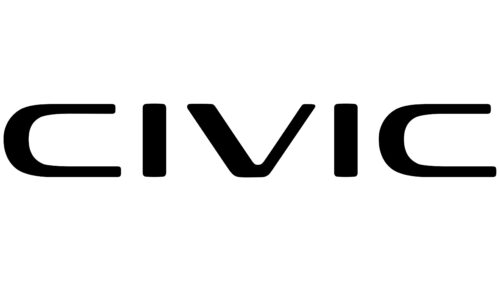The Honda Civic logo is simple and concise, much like the brand’s small cars. The symbols reflect elegance and an optimal modern design. The emblem conveys that eco-friendly and maneuverable cars are the perfect and practical choice for the city.
Honda Civic: Brand overview
The Honda Civic story began in 1972 with a vision of a compact car that didn’t just get you from point A to point B but did so efficiently. The first Civic made its mark with a minimalist design and a petite 1.2-liter engine that sipped fuel like a connoisseur.
By the late ’70s, the Civic had matured slightly, growing a bit in size from 1979 to 1983 and adopting a sleeker, more contemporary look. This was the era when Honda began to ship its economic marvel across the seas to the United States and beyond.
The third generation, rolling out from 1983 to 1987, brought a sporty edge with hatchbacks and sedans that flaunted an aggressive stance. The introduction of the Si models, with their beefed-up engines, added excitement to the Civic lineup.
A bold transformation came between 1987 and 1991. The Civic emerged with a streamlined, modern silhouette that was wider and packed with innovations like all-wheel drive, setting new standards for the compact car segment.
1991 ushered in the fifth generation with a practical twist. This period saw the birth of VTEC engines, marrying fuel efficiency with performance and cementing the Civic’s reputation for versatility.
As the millennium approached, the Civic from 1995 to 2000 became more refined and sporty, its body lines curving gracefully and its aerodynamics honed. The Civic Si of this era became a favorite for its thrilling performance.
From 2001 to 2005, the seventh generation marked a technological leap. The design was smooth and futuristic, and under the hood, the Civic included updated powertrains and even a hybrid version, pushing the envelope of what a compact car could be.
Between 2006 and 2011, the eighth generation saw the Civic adapt to a more compact format, offering a variety of body styles and trims. This era also celebrated the arrival of the Civic Type-R, a high-performance variant that thrilled enthusiasts.
Since 2016, the Civic has continued to evolve, embodying a blend of modern aesthetics and sporty flair while remaining one of the most economical choices on the market.
Over nearly five decades, the Honda Civic has morphed from a simple, efficient, compact car into a dynamic urban vehicle that caters to many drivers. It stands as Honda’s flagship model, beloved by millions around the globe for its reliability, innovation, and style.
Meaning and History
1972 – 1983
Honda initially chose the model name as the logo, emphasizing its importance and uniqueness. The name “Civic” comes from the Latin word “civicus,” associated with citizens and the city, reflecting the idea of creating a compact and convenient urban car.
In the first logo design, each letter was made of metal, symbolizing the car’s endurance and strength. This element highlights the car’s reliability and durability, which makes it capable of withstanding urban conditions. A red groove in the center of each letter represented a pulsating artery, symbolizing the car’s energy and dynamism.
Thin lines on the logo suggest the Honda Civic car’s elegance and high performance. This was important because these cars were initially considered small and designed for agile movement through city streets. The emblem’s black asphalt background added a sense of motion and speed, associating with the road and urban environment.
1983 – 1987
The logo for the third generation of the Honda Civic stood out for its spaciousness and lightness. This logo concept reflected the philosophy of “Maximum space for people, minimum for mechanisms.” This approach allowed for efficient use of the car’s interior space, providing comfort and convenience for drivers and passengers.
The minimalist design of the logo emphasized the company’s commitment to compactness and functionality. Every detail was carefully considered to reduce mechanisms and optimize their placement. This approach created a sense of lightness and space, making the car more appealing to buyers.
1987 – 1991
The logo for the fourth-generation Honda Civic focuses on the letter “V,” which serves as the central element of the design. The “V” is enlarged and cut by a diagonal stripe, evoking the image of a road. This design choice highlights the letter and adds a sense of dynamism and movement to the logo. On either side of the “V,” identical, mirror-like “CI” symbols are placed. This arrangement emphasizes symmetry and harmony, giving the logo a stylish and original look.
The concept for the fourth-generation Civic aimed to provide maximum driving pleasure. The logo’s visual elements reinforce this approach, like the diagonal stripe symbolizing a road. They remind us of the model’s main goal: to create a car that stands out with its design and performance on the road.
1991 – 1995
The fifth-generation logo’s name, “Honda Civic,” is designed as a smooth wave, giving a sense of lightness and grace. The lines connecting the symbols blend seamlessly into the overall design, creating an impression of continuous movement. This effect resembles a beautiful dance, symbolizing the cars’ maneuverability and smooth ride.
The emblem highlights both the vehicles’ dynamic characteristics and their aesthetic appeal. The smooth lines and transitions between the letters emphasize the sleek shapes of the new Civic models. This font style perfectly showcases the aerodynamic and modern features of the fifth-generation cars, giving them a distinctive and stylish look.
1995 – 2000
Even in a simple inscription with black capital letters, the originality of the Honda Civic logo design is evident. The ends of the characters taper elegantly, giving the font a sense of sophistication. The two “C” letters at the beginning and end of the word stand out, resembling horseshoes that symbolize luck and success.
The logo’s letter sizes are balanced, and the neutral black color emphasizes versatility and classic style. These elements represent Honda’s commitment to long-term leadership and enduring popularity in the global automotive market. The Honda Civic becomes synonymous with quality and reliability by creating an image of a car that will remain relevant for years.
Despite its simplicity, the logo design is thoughtfully crafted and symbolically rich. It reflects the company’s aesthetic and philosophical principles. Honda aims to make the Civic a valued and desired car regardless of time and fashion trends.
2000 – 2005
The seventh-generation Honda Civic has been recognized as the Car of the Year. This model transitioned into the compact car category, emphasizing its versatility and convenience for city driving. The logo has been updated to reflect this new stage in the brand’s development. The central “V” in the logo has been transformed into an image of a forked road, symbolizing a new path and the company’s innovative approach.
The smooth curves of the letters in the logo highlight the car’s optimal features. The design of the logo embodies a blend of safety, comfort, and fuel efficiency, which have become key characteristics of the seventh-generation Civic. Every detail of the car addresses the needs of modern drivers, allowing the Civic to gain recognition and become a benchmark in its class.
Special attention has been given to safety, as confirmed by high crash test ratings. A spacious cabin and ergonomic interior design ensure passenger comfort. Advanced technologies and improved engine performance achieve fuel efficiency, making the seventh-generation Civic one of the most attractive options on the market.
2005 – 2011
The sharp lower edge of the letter “V” catches the eye as an original accent, creating visual dynamics. Unique serifs on the lower parts of the letters “C” enhance this feature, adding depth and character to the design. These elements make the brand’s cars impossible to ignore, standing out with their interesting and original aesthetics.
The design of the eighth generation was carefully adapted for each region, considering the preferences and needs of local drivers. Cars in America, Europe, and Asia have unique elements that reflect each market’s cultural and functional aspects. As a result, models for these regions differed significantly, highlighting the brand’s commitment to meeting customer demands worldwide.
2011 – 2015
The company smoothed all edges, creating sleek, streamlined glyphs that emphasize harmony and elegance in design. The ninth generation of cars focused on futuristic elements and comfort, which is evident in every detail. Convenient electronic devices and minimal fuel consumption became essential features of these vehicles.
The company logo was developed with the theme of future cars, featuring maximum automation and flawless performance. Every line and detail of the logo conveyed the idea of advanced technology and high performance, giving the impression that the brand’s cars are at the forefront of the automotive industry.
2015 – 2021
The elegant letters of the inscription are slightly tilted forward to emphasize development and dynamism, reflecting a commitment to innovation and progress. American designers from the parent company developed the tenth generation of cars. They introduced new engines with high efficiency and eco-friendliness and a special driver assistance package that includes collision warning systems, adaptive cruise control, and lane-keeping assistance.
These innovations advanced the cars, providing drivers and passengers with the highest safety and comfort. The black letters of the inscription added a restrained elegance to the appearance, giving the cars an almost executive class. The visual design highlighted the prestige and high status of the cars, making them particularly appealing to those who value refined style and advanced technology.
2021 – today
The “V” is turned halfway towards the viewers, like a new model at an exhibition, drawing everyone’s attention. This design element creates a sense of dynamism and modernity. The elegant “horseshoes” of the “C” represent advanced technical solutions used in the cars, highlighting their innovation and reliability.
The evenly spaced letters emphasize the classic design choice, giving the inscription elegance and formality. The inscription appears smoothly, creating the impression of a silent, very fast sports car with streamlined shapes. This visual presentation focuses on aerodynamics and speed, key characteristics of the brand’s cars.














